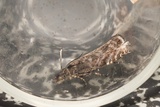Dichrorampha consortana (Stephens, 1852) Species
Last modified: Jan. 18, 2024, 1:14 p.m.
A very rare species and for the first time recorded from Belgium in 2019 (LX).
Details
- Classification
- Family: Tortricidae > Subfamily: Olethreutinae > Tribus: Grapholitini > Genus: Dichrorampha > Species: Dichrorampha consortana
- Vernacular names
- Zilverwortelmot (NL), Downland Drill, Chalk Hill Daisy Moth (EN), Margeritenstängelwickler (DE)
- First mention in Belgium
- Wullaert S. 2021. Resultaten van de Werkgroep Bladmineerders uit 2019 en 2020 met meldingen van 9 nieuwe soorten voor de Belgische fauna (Elachistidae, Cosmopterigidae, Gelechiidae, Noctuidae, Tineidae en Tortricidae) — Phegea 49(3): 109–124. On page 119. view page
- Status
-
Native
Distribution
Caterpillar
Pale yellow body with head and prothoracic plate light brown with dark brown spots, pinacula grey.
Bionomics
The larva bores in the stem of the foodplant causing a weak gall and limiting the growth of the stem. It starts below and bores upwards reach the flower bud which is often is killed, and buds that are situated lower may be stimulated then and develop in several alternative, generally smaller flowers.
The species hibernates in the larval stage. Pupation in a web in the feeding place or in a cocoon in the soil.
Flight periods
One generation a year from mid-May towards mid-June.
Observed on
- Host plant (species):
- Leucanthemum vulgare
The monophagous larva feeds on Leucanthemum vulgare.
Habitat
It inhabits flowery grasslands, meadows and rough ground.

